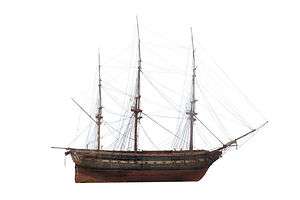French frigate Caroline (1806)
 Hortense, sister-ship of Caroline | |
| History | |
|---|---|
| Name: | Caroline |
| Namesake: | Caroline Bonaparte |
| Ordered: | 24 April 1804 |
| Builder: | Antwerp shipyard (Constructeur: Anne-Jean-Louis Leharivel-Durocher) to plans by Sané |
| Laid down: | May 1804 |
| Launched: | 15 August 1806 |
| Captured: | 21 September 1809 |
| Name: | Bourbonaise[1] |
| Acquired: | 21 September 1809 |
| Fate: | Sold in 1817 |
| General characteristics [2][3] | |
| Displacement: | 1,390 tons (French) |
| Tons burthen: | 1,078 10⁄94 (bm) |
| Length: |
|
| Beam: | 39 feet 10 5⁄8 inches (12.157 m) |
| Depth of hold: | 12 feet 2 inches (3.71 m) |
| Complement: |
|
| Armament: |
|
| Armour: | Timber |
Caroline was a 40-gun Hortense-class frigate of the French Navy. She was launched in 1806, sent to the Indian Ocean in 1809, where she was captured by the British during the Napoleonic Wars. The British renamed the ship to HMS Bourbonaise, as the capture was near Île Bourbon during the British campaign to seize that island and Mauritius, and the British had a ship in service named Caroline.
Service history
Actions in 1807
On 30 November 1807 Caroline captured Charlotte, which Caroline set afire and sank. A week later, on 6 December, Caroline captured the privateer Caesar, which she also set on fire and sank. Caesar was a brig of 217 tons (bm), armed with fourteen 6-pounders and two 18-pounder carronades. Her master, Robert Harrison, had received his letter of marque on 1 January 1807.[4] Caesar had already captured several vessels.
Indian Ocean mission and capture
On 12 November 1808, the French authorities sent four new 40-gun frigates to the Indian Ocean. One of them was Caroline, under the command of Captain Jean-Baptiste Billard, Caroline sailed from Vlissingen in the Netherlands.
Caroline initially patrolled with Manche and Iéna under capitaine de vaisseau Billard. Manche was under the command of Captain Breton and was another of the four; she had sailed from Cherbourg.
Caroline captured several ships, notably the two 20-gun East Indiamen Streatham and Europa on 3 May 1809,[5] before returning to Saint-Paul. A third East Indiaman, Lord Kieth, escaped. Prize crews took Streatham and Europa to Réunion, where the British recaptured them on 21 September.[6]
Billard suffering from very serious illness, Caroline was under the command of his first mate lieutenant de vaisseau Feretier when, on 21 September, HMS Sirius and HMS Raisonnable captured her during the British Raid on Saint-Paul.[6]
HMS Bourbonaise
She was taken into British service as HMS Bourbonaise, there already being a ship of that name in service.
Bourbonnaise was commissioned under Captain Robert Corbett shortly after her capture. He sailed her to Plymouth, where she arrived 16 February 1810. The Admiralty paid her off and laid her up in ordinary. She never went to sea again.[3]
The Admiralty attempted to auction Bourbonaise at Plymouth on 18 September 1816 at £2500, but bidding stopped at £2000. She was broken up in April 1817.
References
- ↑ Winfield, Rif; Stephen S Roberts (2015). French Warships in the Age of Sail 1786 - 1861: Design Construction, Careers and Fates. Seaforth Publishing. p. 144. ISBN 978-1848322042.
- 1 2 Winfield, Rif (2008). British Warships in the Age of Sail 1793–1817: Design, Construction, Careers and Fates. Seaforth. pp. 180–181. ISBN 1-86176-246-1.
- ↑ "Register of Letters of Marque against France 1793-1815". 1812 Privateers. p. 19. Retrieved 7 October 2015.
- ↑ James, William (2015) [1837]. "Naval History of Great Britain - Vol V: 1809 Light Squadrons and Single Ships". P Benyon. p. 194. Retrieved 7 October 2015.
- 1 2 The London Gazette: no. 16341. pp. 213–219. 10 January 1810.
Bibliography
- Roche, Jean-Michel (2005). Dictionnaire des bâtiments de la flotte de guerre française de Colbert à nos jours 1 1671 - 1870. Group Retozel-Maury Millau. ISBN 978-2-9525917-0-6. OCLC 165892922.